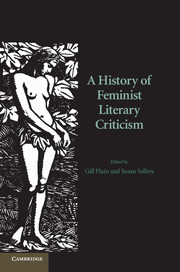Book contents
- Frontmatter
- Contents
- Acknowledgements
- Notes on contributors
- Introduction
- PART I PIONEERS AND PROTOFEMINISM
- Introduction to Part I
- 1 Medieval feminist criticism
- 2 Feminist criticism in the Renaissance and seventeenth century
- 3 Mary Wollstonecraft and her legacy
- 4 The feminist criticism of Virginia Woolf
- 5 Simone de Beauvoir and the demystification of woman
- PART II CREATING A FEMINIST LITERARY CRITICISM
- PART III POSTSTRUCTURALISM AND BEYOND
- Postscript: flaming feminism?
- Index
- References
5 - Simone de Beauvoir and the demystification of woman
Published online by Cambridge University Press: 05 June 2012
- Frontmatter
- Contents
- Acknowledgements
- Notes on contributors
- Introduction
- PART I PIONEERS AND PROTOFEMINISM
- Introduction to Part I
- 1 Medieval feminist criticism
- 2 Feminist criticism in the Renaissance and seventeenth century
- 3 Mary Wollstonecraft and her legacy
- 4 The feminist criticism of Virginia Woolf
- 5 Simone de Beauvoir and the demystification of woman
- PART II CREATING A FEMINIST LITERARY CRITICISM
- PART III POSTSTRUCTURALISM AND BEYOND
- Postscript: flaming feminism?
- Index
- References
Summary
Simone de Beauvoir's The Second Sex (1949) is one of the most famous and influential books of the twentieth century. It had a profound influence on the development of twentieth-century feminism, providing a key theoretical tool in the elaboration of the concept of the social construction of gender and offering a model of feminist enquiry for the theorists, literary critics, historians, philosophers, theologians and critics of scientific discourse who developed the new fields of study which her multidisciplinary essay opened up. Beauvoir's radical attack on the social institutions of motherhood and the family together with her frank discussion of female sexuality led to a public furore on the book's publication in France, a bare five years after De Gaulle at last conceded the right to vote to French women in 1944. The Pope put the book on the list of works which Roman Catholics are forbidden to read and François Mauriac, a leading French novelist and right-wing commentator, led a public campaign to have it banned. However, the media excitement also attracted the attention of the American publisher Knopf who, partly because of a misunderstanding about the book's actual content, commissioned an English translation from a zoologist, Howard Parshley. Parshley's work on the book was undoubtedly a labour of love, but he was obliged by the publisher to make very substantial cuts in the lengthy two-volume text, and was further hampered by the fact that he did not share Beauvoir's training in philosophy.
- Type
- Chapter
- Information
- A History of Feminist Literary Criticism , pp. 85 - 100Publisher: Cambridge University PressPrint publication year: 2007
References
- 7
- Cited by

